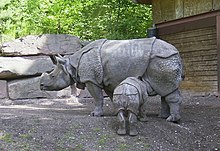Labels:
Central Java,
Fauna of Indonesia
The Javan Rhinoceros (Sunda Rhinoceros to be more precise) or Lesser One-horned Rhinoceros (Rhinoceros sondaicus) is a member of the family Rhinocerotidae and one of five extant rhinoceroses. It belongs to the same genus as the Indian Rhinoceros, and has similar mosaicked skin which resembles armor, but at 3.1–3.2 m (10–10.5 feet) in length and 1.4–1.7 m (4.6–5.8 ft) in height, it is smaller than the Indian Rhinoceros, and is closer in size to the Black Rhinoceros. Its horn is usually less than 25 cm (10 inches), smaller than those of the other rhino species.
Once the most widespread of Asian rhinoceroses, the Javan Rhinoceros ranged from the islands of Indonesia, throughout Southeast Asia, and into India and China. The species is now critically endangered, with only two known populations in the wild, and none in zoos. It is possibly the rarest large mammal on earth. A population of as few as 40 live in Ujung Kulon National Park on the island of Java in Indonesia and a small population, estimated in 2007 to be no more than eight, survives in Cat Tien National Park in Vietnam. The decline of the Javan Rhinoceros is attributed to poaching, primarily for their horns, which are highly valued in traditional Chinese medicine, fetching as much as $30,000 per kilogram on the black market. Loss of habitat, especially as the result of wars, such as the Vietnam War, in Southeast Asia, has also contributed to the species's decline and hindered recovery. The remaining range is only within two nationally protected areas, but the rhinos are still at risk from poachers, disease and loss of genetic diversity leading to inbreeding depression. None are held in captivity.
The Javan Rhino can live approximately 30–45 years in the wild. It historically inhabited lowland rain forest, wet grasslands and large floodplains. The Javan Rhino is mostly solitary, except for courtship and child-rearing, though groups may occasionally congregate near wallows and salt licks. Aside from humans, adults have no predators in their range. The Javan Rhino usually avoids humans, but will attack when it feels threatened. Scientists and conservationists rarely study the animals directly due to their extreme rarity and the danger of interfering with such an endangered species. Researchers rely on camera traps and fecal samples to gauge health and behavior. Consequently, the Javan Rhino is the least studied of all rhino species. On February 28, 2011, a video was released by WWF and Indonesia's National Park Authority which captured two rhinos with their calves. This motion triggered video proved that these animals are still breeding in the wild.


0 comments:
Leave a Reply